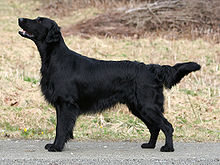Flat-Coated Retriever
The Flat-Coated Retriever is a gundog breed originating from the United Kingdom. It was developed as a retriever both on land and in the water.
Appearance
The Flat-Coated Retriever breed standard calls for males to be 23–24.5 inches (58–62 cm) tall at the withers and for females to be 22–23.5 inches (56–60 cm), with a recommended weight of 45–75 lb (24–34 kg).[1] Flat-Coated Retrievers have strong muscular jaws and a relatively long muzzle to allow for the carrying of birds and upland game. Their head is unique to the breed and is described as being "of one piece" with a minimal stop and a backskull of approximately the same length as the muzzle. They have almond shaped dark brown eyes that have an intelligent, friendly expression. The ears are pendant, relatively small and lie close to the head. The occiput (the bone at the back of the skull) is not to be accentuated (as it is in setters, for example) with the head flowing smoothly into a well-arched neck. The topline is strong and straight with a well feathered tail of moderate length held straight off the back. Flat-coats should be well angulated front and rear, allowing for open, effortless movement. They are lighter, racier and more elegant in appearance than the other retriever breeds.
Temperament
The Flat-Coated Retriever is an active, multi-talented bird dog with a strong desire to please people.[citation needed] Exuberant, confident, and outgoing, they make a loving family pet and can be companions to small children, providing adults are nearby to direct this dog's boisterous enthusiasm. These retrievers require plenty of exercise and engagement to help channel their natural sporting energy.[citation needed] While flat-coats will protect their owners and property with an assertive bark, they are unlikely to back up such noise with actual aggression. Because of their excellent sense of smell, combined with their boundless energy and eagerness to please their master, they are sometimes used as drug-sniffer dogs. They are used in the breeding program for The Guide Dogs for the Blind Association in the UK, both as a breed and as cross-breeds with the Labrador Retriever
Eager and quick to learn, Flat-Coats are best trained in short intervals as they may bore with repetition. This breed retains its youthful, puppy-like outlook and demeanor well into old age. Paddy Petch, author of The Complete Flat-Coated Retriever, refers to these dogs as the "Peter Pan" of the retriever breeds, given they never quite grow up.
History
Originating in the mid-19th century in England, the Flat-Coated Retriever gained popularity as a gamekeeper’s dog. Part of its ancestry is thought to have come from stock imported from North America from the now extinct St. John's water dog, however this is unverifiable. It is thought that Canadian seafarers brought Newfoundlands to British ports and that they factored into the ancestry of the Flat-coat. It is thought that Collie-type dogs were added to increase the breed's trainability along with the Newfoundland for strength and Setter blood for enhanced scenting ability. The first examples of the breed were introduced around 1860, but the final type was only established twenty years later.
After its introduction into the U.S., the Flat-coat began to quickly gain in popularity as a gundog, and from 1873 when the breed became a "stable type" according to the American Kennel Club until 1915 when it was officially recognised as a breed, the number of Flat-coats grew rapidly. However, soon after, the popularity of the Flat-coat began to decrease, eclipsed by the Golden Retriever, which was actually bred in part from the Flat-coat, along with other breeds. By the end of World War II, there were so few Flat-coats that the breed's survival was uncertain. However, beginning in the 1960s, careful breeding brought the population back and the breed gained in popularity again, for both the sport of conformation showing, and as a companion pet. Today, the Flat-coat enjoys a modest popularity and is moving ahead as a breed through attentive breeding for the conformation, health, multi-purpose talent and exceptional temperament that are its hallmarks. It has yet to return in substantial numbers to field competition.
In 2011, Sh Ch. Vbos The Kentuckian (aka Jet), a 9.5 year old Flat-coat from South Queensferry, near Edinburgh, Scotland, won Best in Show at Crufts.Almanza Far and Flyg (a.k.a. Simon), from Oslo, Norway, won the Gundog Group at Crufts in 2007. Before that in 2003 a Swedish Flat-coat "Inkwells Named Shadow" had also won the Gundog Group. The last UK Flatcoat to win the Gundog Group at Crufts was "Sh Ch Gayplume Dream-maker" in 2002. The only other Flatcoat to win Best in Show at Crufts was Ch. Shargleam Blackcapin 1980. These wins have contributed to the breed's popularity in Europe and the United Kingdom.
 | ||||||||||||||||||||||||||||
| A black Flat-Coated Retriever | ||||||||||||||||||||||||||||
| Nicknames | Flatcoat, Flattie Flatte, (Sweden) flatt, (Sweden) | |||||||||||||||||||||||||||
|---|---|---|---|---|---|---|---|---|---|---|---|---|---|---|---|---|---|---|---|---|---|---|---|---|---|---|---|---|
| Country of origin | United Kingdom | |||||||||||||||||||||||||||
| ||||||||||||||||||||||||||||
| ||||||||||||||||||||||||||||






No comments:
Post a Comment